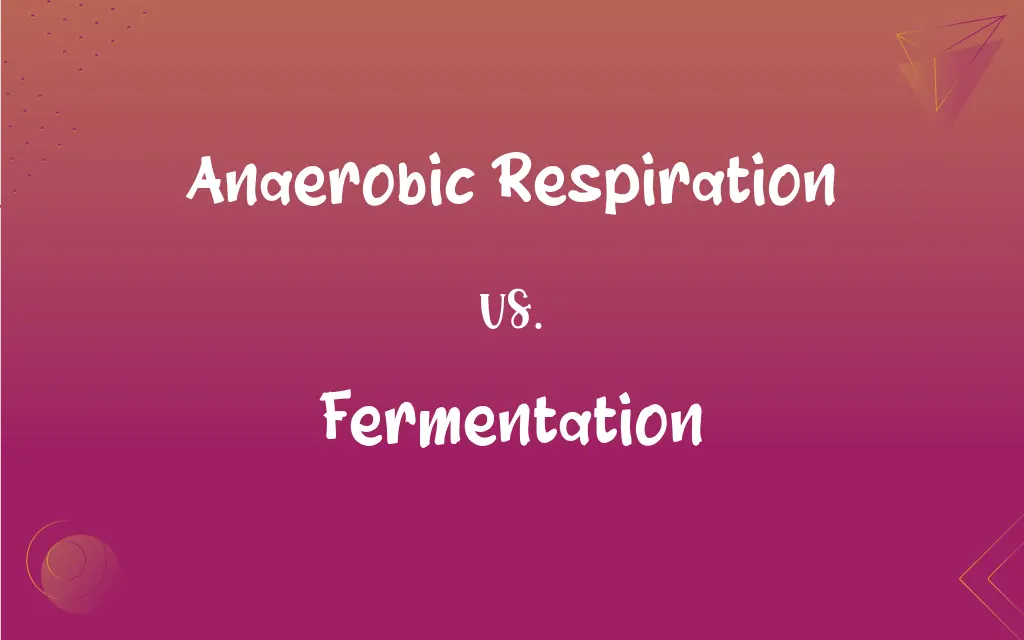Anaerobic Respiration vs. Fermentation: What's the Difference?
Edited by Aimie Carlson || By Harlon Moss || Updated on October 30, 2023
Anaerobic respiration is energy production without oxygen, producing ATP and different end products, while fermentation is a specific form of anaerobic metabolism that produces ATP without the electron transport chain, often resulting in ethanol or lactic

Key Differences
Anaerobic respiration is a process by which cells produce energy in the absence of oxygen. It is an alternative pathway for energy production when oxygen is scarce. This method of respiration uses an electron transport chain and produces a variety of end products, depending on the organism. On the contrary, fermentation is a specific type of anaerobic metabolism where cells produce energy without using an electron transport chain, resulting in the production of specific organic compounds like ethanol in yeasts or lactic acid in muscles.
In the process of anaerobic respiration, glucose is broken down to generate ATP. While less efficient than aerobic respiration (which uses oxygen), it enables organisms to produce energy when oxygen is not available. Meanwhile, fermentation is used by many organisms, including bacteria and yeasts, as a means to regenerate NAD+ from NADH, ensuring that glycolysis, a primary energy-producing pathway, can continue.
Both anaerobic respiration and fermentation allow for survival and energy production in environments lacking oxygen. However, the end products of these processes differ. In some types of anaerobic respiration, the end products might be compounds like sulfate, nitrate, or sulfur. In contrast, fermentation processes in yeasts typically produce ethanol and carbon dioxide, while in human muscle cells, lactic acid is the primary end product.
The energy yield from anaerobic respiration is generally higher than that from fermentation because it uses an electron transport chain to produce ATP, while fermentation bypasses this. However, both these processes are critical for various organisms, allowing them to thrive in diverse environments where oxygen might be limiting.
While both anaerobic respiration and fermentation are essential for certain organisms, they are not the primary energy-producing mechanisms in human cells. Humans primarily rely on aerobic respiration but will resort to fermentation in specific situations, like strenuous exercise, where oxygen supply to muscles is temporarily insufficient.
ADVERTISEMENT
Comparison Chart
Oxygen Requirement
Does not require oxygen
Does not require oxygen
Electron Transport Chain
Utilizes an electron transport chain
Does not use an electron transport chain
Energy Efficiency
Generally higher energy yield
Lower energy yield
End Products
Various (e.g., sulfate, nitrate)
Specific (e.g., ethanol, lactic acid)
Primary Function
Energy production in oxygen-poor conditions
Regenerate NAD+ to sustain glycolysis
ADVERTISEMENT
Anaerobic Respiration and Fermentation Definitions
Anaerobic Respiration
Anaerobic respiration involves an electron transport chain, albeit without oxygen.
Despite lacking oxygen, some organisms generate ATP efficiently via anaerobic respiration.
Fermentation
Fermentation results in specific organic compounds as by-products.
The brewing industry relies on fermentation to produce alcoholic beverages.
Anaerobic Respiration
Anaerobic respiration is energy production in cells without using oxygen.
In waterlogged soils, some bacteria use anaerobic respiration due to the absence of oxygen.
Fermentation
Fermentation is a metabolic process generating energy without oxygen or the electron transport chain.
Yeasts undergo fermentation, producing ethanol and carbon dioxide.
Anaerobic Respiration
Anaerobic respiration is an alternative to aerobic respiration when oxygen is limited.
Deep-sea microbes often rely on anaerobic respiration due to the low oxygen availability.
Fermentation
Fermentation is an anaerobic process producing ATP without fully oxidizing glucose.
In the absence of oxygen, cells can resort to fermentation to maintain energy production.
Anaerobic Respiration
Anaerobic respiration uses molecules other than oxygen as electron acceptors.
Some bacteria utilize nitrate in anaerobic respiration, converting it to nitrogen gas.
Fermentation
Fermentation regenerates NAD+ to keep glycolysis running.
In strenuous exercise, human muscles use fermentation, leading to lactic acid buildup.
Anaerobic Respiration
Anaerobic respiration yields ATP without oxygen involvement.
In certain extreme environments, organisms depend on anaerobic respiration for survival.
Fermentation
Fermentation is essential for many microbes and certain eukaryotic cells under specific conditions.
In making yogurt, bacterial fermentation turns lactose into lactic acid, giving it a sour taste.
FAQs
Can humans undergo anaerobic respiration?
Humans primarily use aerobic respiration, but muscles can resort to fermentation under intense exercise.
Why do yeasts undergo fermentation?
Yeasts use fermentation to produce energy in oxygen-deprived conditions, resulting in ethanol and CO2.
Is fermentation beneficial for industries?
Yes, fermentation is crucial in industries like brewing, baking, and dairy production.
How does fermentation differ from anaerobic respiration?
Fermentation is a specific form of anaerobic metabolism without an electron transport chain, producing specific end products like ethanol or lactic acid.
Why is the energy yield of anaerobic respiration generally higher than fermentation?
Anaerobic respiration uses an electron transport chain, which generally results in a higher ATP yield.
Can plants undergo anaerobic respiration?
Yes, under oxygen-deprived conditions, like waterlogged soils, plants can resort to anaerobic respiration.
Does fermentation always result in alcohol production?
No, fermentation can produce various end products; for example, in muscles, it produces lactic acid.
What is anaerobic respiration?
Anaerobic respiration is energy production in cells without the presence of oxygen.
What role does NAD+ play in fermentation?
Fermentation regenerates NAD+ from NADH, allowing glycolysis to continue producing ATP.
Why do pickles and sauerkraut taste sour?
The sour taste is due to fermentation by bacteria, producing organic acids like lactic acid.
Are the end products of anaerobic respiration always the same?
No, the end products vary depending on the organism and can include compounds like sulfate or nitrate.
What is a common by-product of fermentation in muscles?
Lactic acid is a typical by-product of fermentation in human muscle cells.
Why is bread dough left to rise?
Dough rises due to fermentation by yeast, producing CO2 which causes the dough to expand.
Is ATP yield the same in anaerobic respiration and fermentation?
No, generally, anaerobic respiration yields more ATP than fermentation.
How do organisms benefit from anaerobic respiration?
It allows them to produce energy in environments where oxygen is limited or absent.
Can anaerobic respiration occur in the presence of oxygen?
While it's designed for oxygen-lacking conditions, some organisms can perform anaerobic respiration even if oxygen is present.
Which organism is commonly associated with fermentation in alcoholic beverages?
Yeast is typically responsible for fermentation in the production of alcoholic beverages.
Are there any drawbacks to anaerobic respiration in humans?
While beneficial under stress, prolonged anaerobic processes in muscles can lead to lactic acid buildup, causing fatigue and soreness.
Is oxygen harmful to organisms that rely solely on anaerobic respiration?
For some strict anaerobes, oxygen can be toxic and detrimental to their survival.
Why is fermentation considered inefficient compared to aerobic respiration?
Fermentation bypasses the electron transport chain, resulting in a lower ATP yield compared to both aerobic respiration and some forms of anaerobic respiration.
About Author
Written by
Harlon MossHarlon is a seasoned quality moderator and accomplished content writer for Difference Wiki. An alumnus of the prestigious University of California, he earned his degree in Computer Science. Leveraging his academic background, Harlon brings a meticulous and informed perspective to his work, ensuring content accuracy and excellence.
Edited by
Aimie CarlsonAimie Carlson, holding a master's degree in English literature, is a fervent English language enthusiast. She lends her writing talents to Difference Wiki, a prominent website that specializes in comparisons, offering readers insightful analyses that both captivate and inform.































































